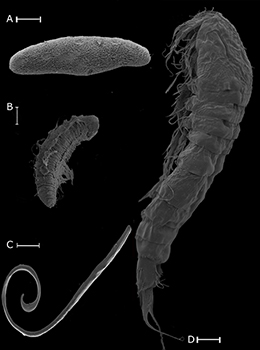Extending new discoveries in the deep subsurface – UFS paper published in Nature Communications

Scanning electron microscopy of some of the Eukarya recovered from two different mines. (a) Dochmiotrema sp. (Plathyelminthes), (b) A. hemprichi (Annelida), (c) Mylonchulus brachyurus (Nematoda), (d) Amphiascoides (Arthropoda). Scale bar, 50 µm (a,b), 100 µm (c), 20 µm (d).
|
Following the discovery of the first Eukarya in the deep subsurface (Nature, 2010) by a research group from the Department of Microbial, Biochemical, and Food Biotechnology at the University of the Free State (UFS) and their international collaborators, intense interest has developed in understanding the diversity of more complex organisms living in these extreme environments.
Prof Gaetan Borgonie from Extreme Life Isyensya, together with a group of UFS researchers, took this research further, resulting in a paper on this research released in Nature Communications – impact factor 11.47. This paper is an extension of the first reports of more complex life at great depths, and their abilities to survive these harsh conditions.
Ten authors from the UFS contributed with the array of expertise needed to define this discovery. The group was supported by staff from the different mining groups, long-term leading collaborators from the USA and Canada, and the idea specialist driver of the paper, Prof Borganie.
“After a sampling campaign that lasted more than two years, we identified that Platyhelminthes, Rotifera, Annelida and Arthropoda are thriving at 1.4 km depths in fissure water up to 12,000-years old in the South African mines of Driefontein and Kopanang,” said Prof Borgonie, who was appointed as associated researcher in the Department of Microbial, Biochemical, and Food Biotechnology.
This paper really opens a “can of worms” so to speak. According to Prof Esta van Heerden from the Department of Microbial, Biochemical and Food Biotechnology at the UFS they extended to define protozoa and fungi. “However, they are present in low numbers,” she said.
Characterisation of the different species reveals that many are opportunistic organisms. In house-adapted video equipment was used to film inside the fissure for the home of the organisms.
This is the first-known study to demonstrate the in situ distribution of biofilms on fissure rock faces using video documentation. Calculations suggest that food, not dissolved oxygen, is the limiting factor for population growth. The discovery of a group of complex multicellular organisms in the underground has important implications for the search for life on other planets in our solar system.
More articles
The strange beasts that live in solid rock deep underground
A microscopic ‘zoo’ is found deep, deep underground